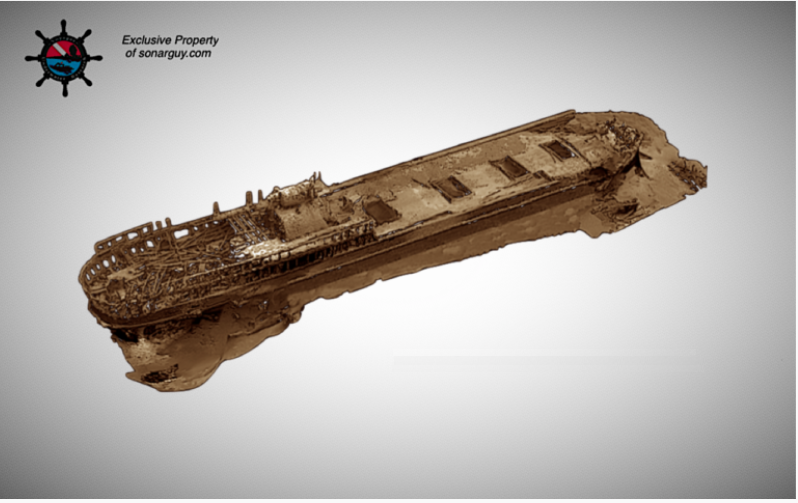

Unidentified Schooner
This wreck was previously discovered in June of 2016 by Jim Kennard, Roger Pawlowski and Roland Stevens. It was believed to be the Royal Albert that sunk in Lake Ontario on August 9, 1868 with a cargo of 285 tons of railroad iron in its holds. On June 30, 2025 we were out mapping the lake when we came across this wreck. After 3 dives on the site we found that it was full of coal up to the gunnels with no iron rails aboard. Therefore the Royal Albert is still out there waiting to be found. Further research is ongoing to identify this shipwreck. For more discoveries go to https://sonarguy.com
The Etta Belle
We did a ROV dive on the Etta Belle on August 22, 2025 at 10:30 at night to produce this 3D image of the wreck. The Etta Belle sunk on Sept. 3, 1873 after it was discoverd to have a substantial leak. The flow of water coming in was more then the pumps could keep up with causing her to foundered.
The original discovery of the Etta Belle was in the fall of 2003 by Dan Scoville and Jim Kennard. You can go to Dan Scoville's website at https://www.shipwreckstories.com/etta-belle for more information.
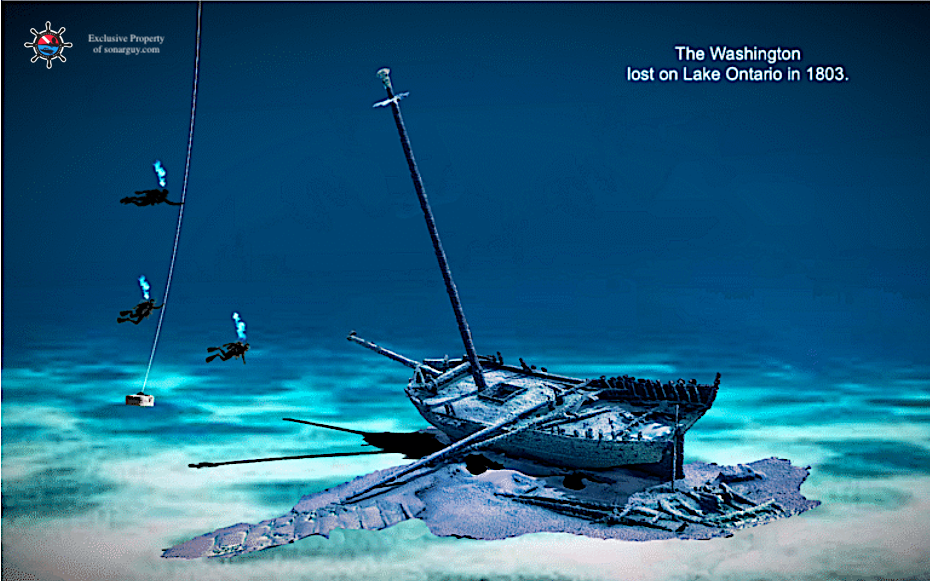
Please note this image is just a representation of what scuba diving can be someday in Lake Ontario. We are currently working in cooperation with NOAA under a LAKE ONTARIO NATIONAL MARINE SANCTUARY RESEARCH PERMIT, Permit Number: LONMS-2025-001. This is all in an effort to document known and unknown shipwrecks in the hopes of protecting these valuable resources for future generations.
The Washington lost on Lake Ontario in 1803.
During one of our sonar surveys in Lake Ontario on July 9, 2025 we came across this wreck. It appeared to have a mast still standing as well as a bowsprit clearly visible on the sonar scan. We did an ROV dive on it that same day and immediately recognized it as the Washington that was previously discovered in 2016 by Jim Kennard, Roger Pawlowski, and Roland Stevens during one of their sonar surveys. It was a long day on the lake that day so we returned to the wreck site on July 11 to do a full 3D model of the Washington. It came out pretty good with the exception of the mast that are very difficult to do. For information on the original discovery and history of the Washington go to, https://www.shipwreckworld.com/articles/sloop-washington-discovered-lake-ontario More 3D image of wreck
The Abandoned Shipwreck Act of 1987
Historical shipwrecks abandoned and buried in New York State underwater lands belong to the people of New York State and are protected by state and federal laws from unauthorized disturbance.

Display at the H. Lee White Museum in Oswego.
This display represents 3-D scaled models of shipwreck discoveries in Lake Ontario and various Central New York waterways by Tim Caza and Dennis Gerber. The display is currently on loan to the H. Lee White Museum in Oswego for the public's enjoyment. The display represents numerous hours of research and discoveries in the summer seasons. Tim and Dennis take all the data collected as well as thousands of photographs of each vessel to produce a 3-D model of the sites. When the research boat is dry docked for the winter Tim goes to work in sculpting and painting the models to represent exactly how they set on the bottom of the lake undisturbed. Over the winter Tim finished nine new 3-D models that was added to the display in the spring of 2025. Building Models
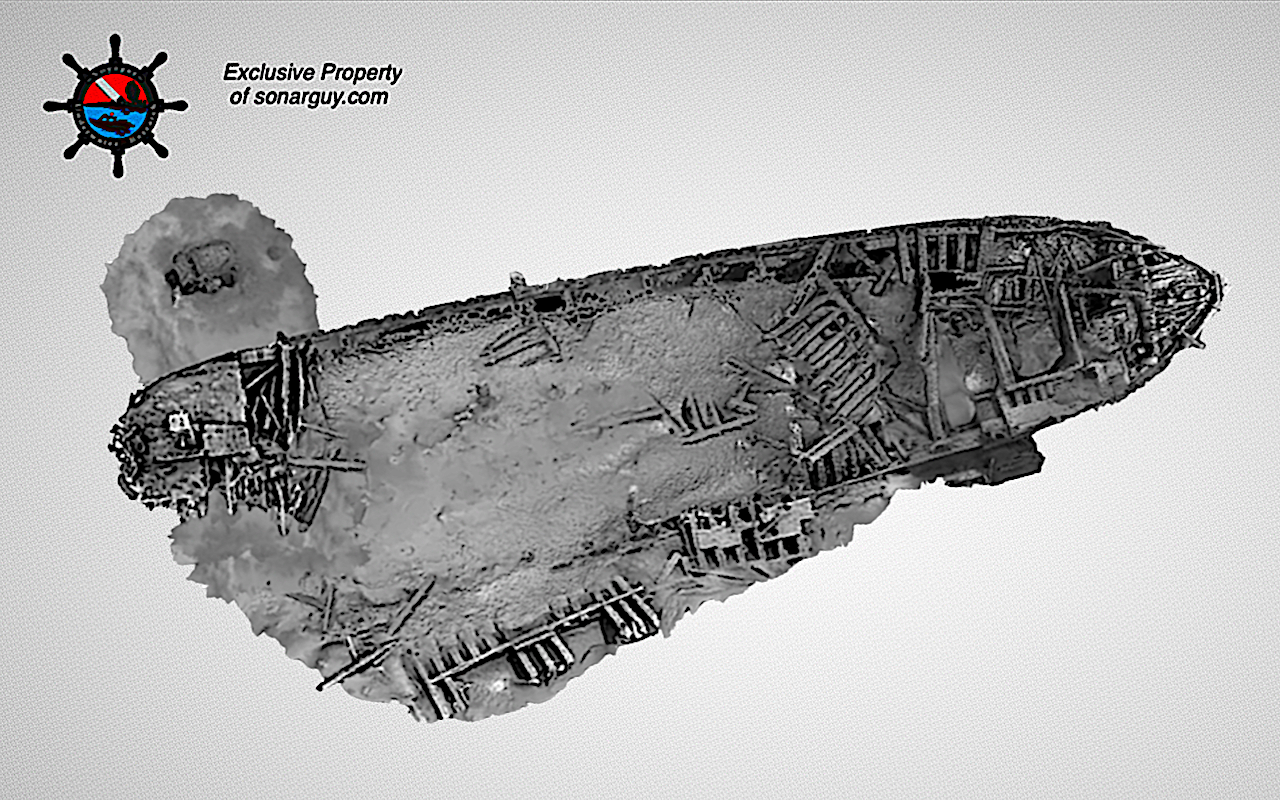

The Orion
Tim and Dennis were out sonar surveying on the night of October 19, 2024 when they came across this target that turned out to be the same target that Jim Kennard, Roger Pawlowski and Roland Stevens located in October of 2013 that they believed was the steamer Roberval. After we did numerous underwater surveys of the site it appears that the original assessment of it being the Roberval by Kennard and his research team was incorrect. The wreck site is actually all wood not a steel steamer.
It is very difficult to identify many of these shipwrecks that have sunk over the years. We have made some incorrect identifications ourselves, but with new technology and equipment it has made it easier to identify some of them.
There has been many ROV dives by Tim and Dennis to try to identify the wreck site. The wreck was also documented in May of 2025 by NOAA and the Ocean Exploration Cooperative Institute using a remotely operated vehicle. Ben Ioset Maritime Archaeologist NOAA's Office of National Marine Sanctuaries has done extensive research to uncover that this site is indeed the final resting place of the Orion. You can read more of the history of the Orion by Ben Ioset here. History 3D image of wreck More


The Roberval
We discovered this steamer on July 2, 2024 during one of our routine sonar surveys. After a ROV survey of the wreck site that same day we found it to be remarkably intact for being so deep below the surface. We were able to observe that it had a full load of stacked lumber in the cargo bays with a large stack of lumber resting on top of the back cabin. We could tell that the steamer went down stern first based on the way she is resting on the bottom of the lake. There is also quite a bit of lumber jammed against the back of the forward bunkhouse. On the starboard side resting on the bottom of the lake is the roof of the forward pilot house that was apparently dislodged when it struck the bottom stern first. There is also a dingy resting on the bottom on the starboard side. On the port side the back cabin house roof is peeled back with the smokestack also laying back at an angle. The dingy on the port side is missing and the portside back cabin is crushed. It appears that this damage was done by the bundle of lumber that is now resting on the back cabin. There is also one porthole window open on the port side front bunkhouse. After all the research we have done on this site we have found that this is the Roberval Steamer that was lost on Lake Ontario September 26, 1916. Click on this tab to read the report from the survivors of the sinking of the Roberval. Read More 3D image of wreck More

Tekakwitha is an Iroquois name that can be translated as, “One who places things in order” or “To put all into place”; other translations include, “She who bumps into things”, “She pushes with her hands” and “Who walks groping for her way” (because of her faulty eyesight.). This is surely a fitting name for a tugboat.
The Tekakwitha tug. We picked up this target on July 2, 2024 and made an attempt to reach it with our ROV but unfortunately due to the current and the depth of water we did not accomplish this. It wasn’t until July 22, 2024 when the weather was favorable to try to reach the site again. Unfortunately, after two attempts the current was really giving us a problem down deep so we came up with another plan of how to reach the site. After the third attempt we finally were able to approach the wreck. It was well worth the headaches for this was one of the most pristine wrecks we have ever found. The letters on the front of the pilot house clearly spelled out the name Tekakwitha. All evidence so far on site appears to show that the tug was being towed somewhere. The tug sank in the Oswego river near lock 23 in Brewerton in November of 1992. It was salvaged and towed to Oswego for winter port. The tug was sincerely damaged from the sinking. Why did the tug sink again in the deep waters of the lake? Further research is being done to try to answer this question. History 3D image of wreck More

The lost steamer Iona:
Tim Caza and Dennis Gerber found this wreck site in July of 2024 and did not identify it until they returned on July 8, 2024 to explore the site with their ROV. It turned out to be another steamer that has a cargo of coal on board. The stern section near the boiler appears to have had a fire that was most likely the reason for it sinking. Thanks to Benjamin Ioset and Jim Kennard for helping to identified this steamer as the Iona lost on May 23, 1912.
You can read more on, https://images.maritimehistoryofthegreatlakes.ca/79119/data

Two mast schooner:
Tim and Dennis found a total of four targets in July of 2024. This was the third target that we put the ROV down on in July. This wreck site turned out to be a schooner that has both the masts lying down across her deck. The cabin in the stern has totally collapsed and it has a cargo of coal aboard.

The Farmer's Daughter
This site is the fourth target we came across in July of 2024 after a 17-hour survey that day. We did not dive this site until July 8 with the ROV. Based on the sonar survey we could tell that it was a schooner with two masts still standing on it. Because it had standing mast, we had to plan this dive carefully. After putting a plan together as to how to approach the site so we could stay clear of the masts, we did the dive and stuck to the dive plan. The dive was a total success and it immediately came clear to Tim that this schooner was the Farmer’s Daughter that was discovered in July of 2012 by Dan Scoville and Chris Koberstein. For the original discovery story go to Dan Scoville’s web site at https://www.shipwreckstories.com/farmers-daughter. 3D image of wreck More


T.J. Waffle Steamer
On August 22, 2020 Dennis and I found a steamer 20 miles off Oswego that we believed to be the T.J. Waffle, well we proved ourselves to be wrong. We came upon this steamer on June 2, 2024 in the same area of the lake and after extensive research we have found that this steamer is actually the T.J. Waffle.
The steamer went missing in heavy weather on Sept. 22, 1919, while bound from Fairhaven, NY to Kingston, Ontario. Some wreckage came ashore at Burt Point, near Oswego. Much of it was so thoroughly splintered that speculation was that she had exploded her boiler. Another steamer reported seeing a mess of wreckage off the Main Duck Island area. Winds were strong from the northeast that blew the wreckage south to Oswego. The cabin top was found on the beach near Oswego along with pillows and lifejackets with the steamer’s name on them. One woman and five men lost their lives that night. Captain Charles Beaupre, William Switzer, engineer Russel David, mate William Sweet and cook Mrs. William Sweet, wife of mate. Other crew members names not known. It has been 105 years since the loss of the T.J. Waffle steamer and by the looks of the site it appears that there was an explosion onboard as was speculated on the T.J. Waffle’s final voyage. It was a terrible tragedy for those who worked upon her decks that night.

The David B. Mills
The David Mills is a well-known wreck site that rest a half-mile offshore in 25 feet of water on the east side of Ford Shoals in Lake Ontario just west of Oswego, NY.The Mills was a wooden steam barge 202 feet in length, 34 feet wide and 13 feet to her keel. The Mills came into service in 1874 and struck Ford Shoals at full speed in 1919. The largest section that remains has the propeller shaft and propeller still attached. A short distance to the west of that section is another large section, mainly ribs and boards. If you continue to the NW of this section on Ford Shoals in shallow water you will find the boiler to the Mills. There's also an anchor nearby and various pieces scattered about. 3D image of wreck
The side of the David B. Mills
This is the second largest piece of the David Mills. This section is just west of the largest piece on the side of Ford Shoals. 3D image of wreck
 The David Mills Boiler
The David Mills Boiler

Tug Mary Kay
The Mary Kay tugboat was built in 1957 and after 31 years of service she sank off the Oswego shoreline in September of 1988. The Mary Kay is a popular dive site sitting in 42 feet of water. The stern section is intact with her engine visible. The midsection of the tug is missing with a portion of her bow section tipped to the starboard side. Much of the rest of the wreck is scattered to her portside.

21 foot Boston Whaler
On the night of Sept. 28, 2023 during a sonar survey in Lake Ontario we picked up this target. We returned to the site on Sept. 30, 2023 with our ROV to see what it was. It turned out to be a 21 foot Boston Whaler with a Evinrude outboard motor on it as well as a Johnson trolling motor, along with a full set of downriggers. Further research showed that the boat belonged to Mike Tanner. There were two aboard fishing that day Mike and his friend Terry both had a fish on their lines standing on the back of the boat. Water came over the back of the stern and the boat went down quickly. They were lucky to have been seen by a passing fishing boat from Sandy Creek called the Pisces that picked them up. Mike's fishing boat now rests in deep waters of Lake Ontario.

Houseboat
We came across this target on Sept. 9, 2023 doing a sonar survey and later returned with a ROV on Sept. 15, 2023 to see what it was. It turned out to be a 32 foot late 1960s era Sea Rover houseboat that sank on Sept. 14, 1973. It rest in 500 feet of water on the bottom of Lake Ontario
This houseboat was originally found by Dan Scoville & Chris Koberstein in the summer of 2012. To see the original discovery information go to,
https://www.shipwreckstories.com/zerwas-houseboat

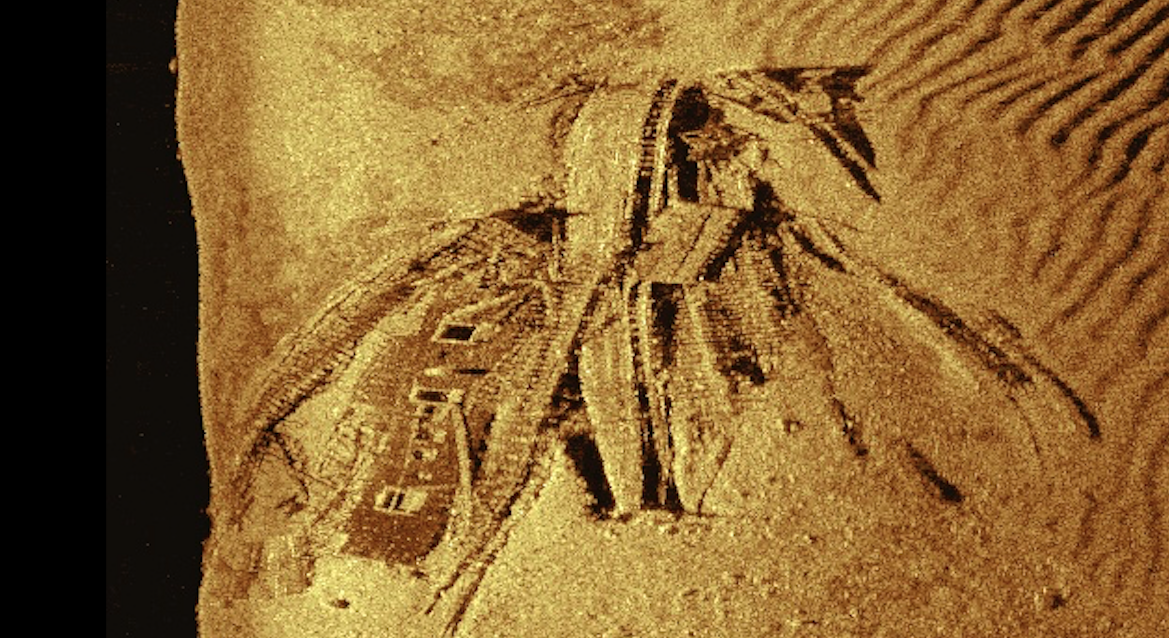
Two shipwrecks one on top of the other.
Tim Caza and Dennis Gerber picked up this target on September 19, 2014. After Tim dove the site, He felt that we had 2 wrecks one on top of the other. We had a good idea of what wrecks these were but we were not ready to announce it until we could be sure that we had two ship wrecks on this site. On July 5th through July 14 of 2023 we were working with Ben Ford, Professor and Chairperson Anthropology from Indiana University of Pennsylvania, and Carrie Sowden, Archaeological and Research Director from the National Museum of the Great Lakes, as well as with two students on another site, a daggerboard scow schooner off Gallo Island. After completing the survey off of Gallo Island, we took the survey team out to the site of what we believed was two shipwrecks. After they dove the site both Ben and Carrie’s conclusion was that we did indeed have two shipwrecks on this site. It is our belief that we have found the M. Ballard that sunk in Dec. of 1866 after striking a shoal at the head of Gallo Island and the second one that is currently being investigated to figure out which one it is.

The Dredge Gordon
The Dredge Gordon sunk on November 17th 1879 in Lake Ontario. The Gordon was found by Dan Scoville & Chris Koberstein on July 5th 2012 off Oswego, NY. The dredge sunk after being struck in the stern by the tug Philip Becker.
The dredge was in a fleet that consisted of 5 tug boats, three dredges and 10 scows. The Philip Becker was also lost that night as well as the tug A.O. Thayer and some of the scows.
Tim Caza and Dennis Gerber returned to the site of the Dredge Gordon on June 30, 2023 to do this 3D image 3D image of wreck Multi-Beam Sonar Image More
To see the original discovery information go to, https://www.shipwreckstories.com/dredge-gordon
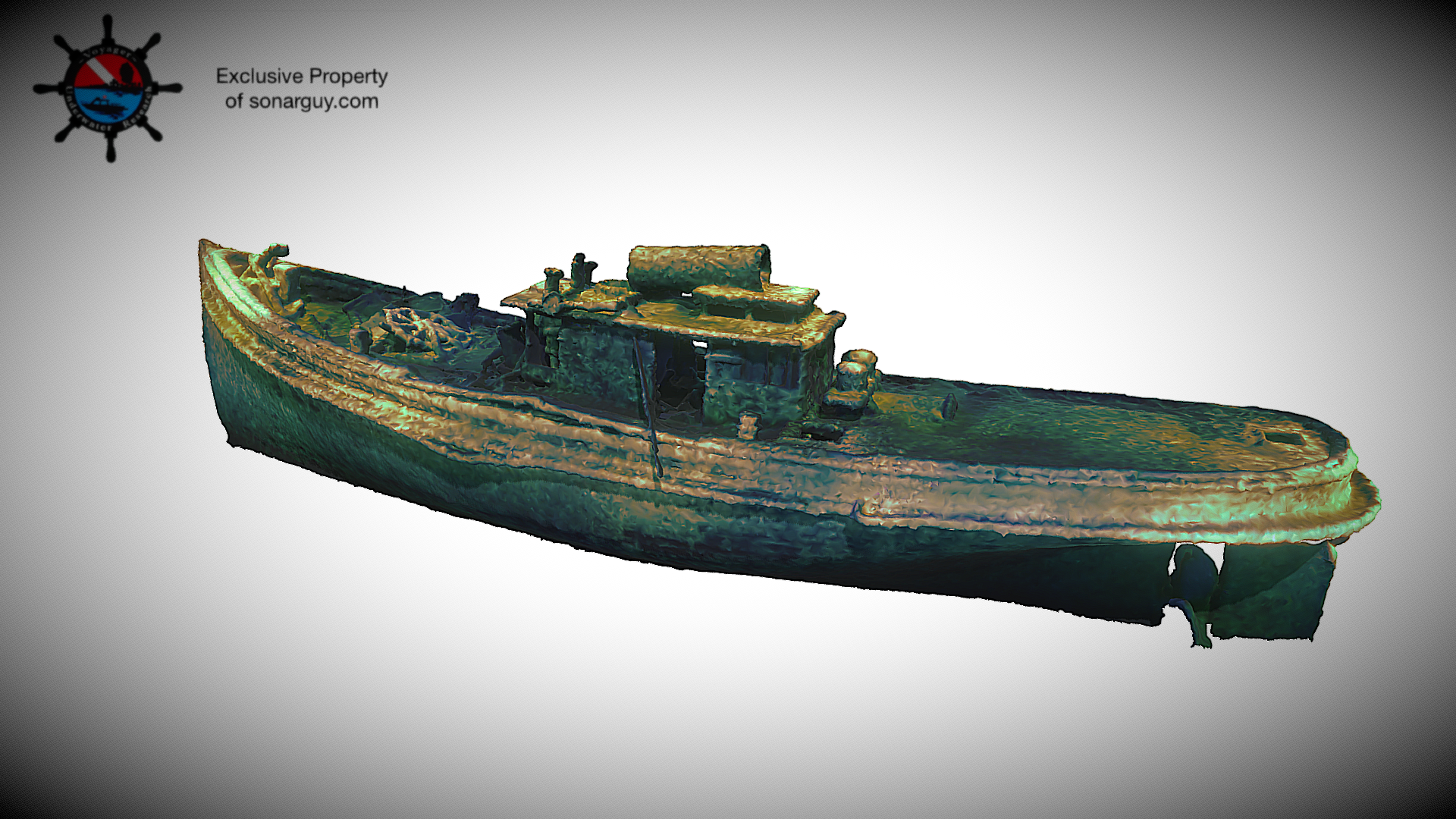
Tug Boat found in Lake Ontario
We came across this tug in deep waters of Lake Ontario on June 14, 2022. The tug measures 50 feet in length by 12 feet at its widest point. She is remarkably intact with the exception of the front pilot house that has collasped with the shipwheel laying on the deck.
It is believed that this tug may be from the tragedy that took place on Lake Ontario the night of November 21, 1879 with the sinking of the Dredge Gordon and two tugs. All indications at this point seems to be that this tug is the Philip Becker.
Aerial drone shots were taking on July 7, 2022.




Daggerboard Scow Schooner
This Daggerboard Scow Schooner was first visited on June 25, 2022 with side scan sonar, underwater video and photographs taken by Tim Caza and Dennis Gerber. You can clearly see where the two masts would’ve been as well as a daggerboard between them. You can also see where the windlass remains are at the bow of the vessel. The Daggerboard Scow Schooner rough measurements are 78 feet long by 16 foot wide. Her final resting place is on the bottom of Lake Ontario. After further investigation we have determined that this is the wreck of the Northern Lights. Thanks to Brandon Kampnich for the lead on this daggerboards schooner.

These measurements were taken on July 7, 2022 with further studies planned at Galloo Island.
Shallow water wrecks
Although there are many shallow water wrecks beneath the sand along the shorelines of Lake Ontario it is not uncommon after a big storm for them to be unearthed like this one was in Mexico Bay.
This wreck is known as the Point Peninsula wreck.
It is believed to be the remains of the schooner Minerva Cook.
The pictures below courtesy of Dennis McCarthy in1975 when he dove the wreck, because of the shallow water the wreck is in bad shape.


Canal Boat in Lake Ontario
We came across this canal boat in July of 2023 and did this 3D image of it. It was originally located by Jim Kennard, Roger Pawlowski, and Roland Stevens using DeepVision side scan sonar in the season of 2014.
For more Information on this particular canal boat go to: https://www.shipwreckworld.com/articles/canal-boats-from-1800s-found-in-lake-ontario
Two mast schooner believed to be the Nellie P. Downey that sunk on June 12, 1884.
Tim Caza and Dennis Gerber came across this two masts schooner in Lake Ontario on August 28, 2022 while doing a sonar survey. Because of the depth of the water the only way the site could be reached was with a ROV, (Remote operated vehicle). We returned to the site on September 17, 2022 to explore the wreck site. Much to our surprise it turned out to be remarkably intact. The schooner is setting up right on the bottom of the lake. After further investigation with the ROV it was noted that it appears to have been involved in a collision with another vessel striking her port side. It was obvious to us that this is the reason why this vessel went down not due to the bad weather that night. We spent over six hours above the wreck site that day and the video we took produced 8,377 photographs to do this 3-D model. Based on our investigation it appears that it is a vessel that Dan Scoville & Chris Koberstein found July 2013. They we're unable to identify it at the time but it is believed to be the Nellie P. Downey based on Ben Ioset an archaeologists working for NOAA. She is also in the location that it was thought to be lost. For more information on the original discovery go to,
https://www.shipwreckstories.com/2013-unidentified-1
The Black Duck
The Black Duck is a scow-sloop with a length of 51 feet and a beam of 13 feet with a depth of only 4 feet. She was built on Wellesley Island in the St. Lawrence River in 1859. It was loaded with coal and left Oswego, New York for Sackets Harbor on August 8, 1872 when it foundered in a northwest gale. In May of 2013 Jim Kennard and Roger Pawlowski, found the shipwreck with sonar and then returned in September of 2016 with a VideoRay Pro IV. The team was able to survey the shipwreck and make the identification as the scow-sloop Black Duck. Dan Scoville and Chris Koberstein had also visited the shipwreck with their ROV in July 2013.
Tim Caza and Dennis Gerber returned to the site on October 23, 2022 with their equipment to produce this 3D image of the Black Duck resting in deep waters of Lake Ontario.
For more info go to, https://www.shipwreckstories.com/black-duck


The Cormorant in Lake Ontario
This tug boat was built in 1941 and in 1949 it was renamed the Russell 4 and was sold to the Newton Creek Towing Company of New York. The tug was repurchased by Merrit, Chapman & Scottt who renamed the tug Cormorant. The Cormorant was returning from work on the St. Lawerence River when just 3 miles NE of Oswego she was swamped by a large wave. The crew survived by hanging onto a tractor tire that they retrieved when crossing the lake.
In 1996 Tim Shippee, Doug Low, Peter Tombollio and Robert Kutzleb were surveying the area and found the Cormorant with sonar. They later put two divers down, Peter Tombollio & Walt Ciesla, who identified and photographed the tug boat. Depending on the time of the year, the average depth of the Cormorant site is 130 feet.
Since the discovery in 1996 there have been many experienced divers that have visited the tug Cormorant. We returned to the site of the Cormorant on June 21, 2022 to do some photogrammetry work with it. We used 3,413 photographs to produce all the 3-D images of the Cormorant.

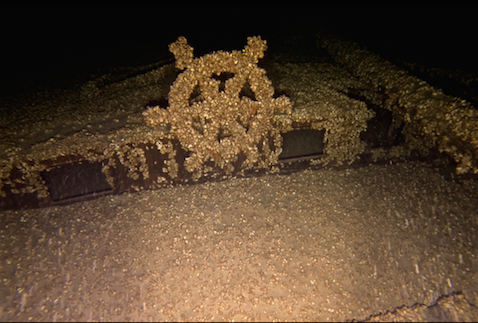
Believed to be the William Elgin sunk on May 21, 1818
The site of the William Elgin was originally discovered by Tim Shippee and his 13 year old daughter Ariel on September 1, 1997. Tim Shippee and Dennis Gerber later attempted to gather some photographs of the site with a drop camera but were unsuccessful. It wasn’t until nine years later in the summer of 2006 when they were finally able to identify the site, thanks to Dan Scoville and Jim Kennard.
Dan Scoville was eager to test an underwater ROV on a deep site that he and the students from the Rochester Institute of Technology had just developed. This was a perfect opportunity. They were able to gather the first images of the site and with the help from Jim Kennard they were able to identify the site as the wreck of the William Elgin, a two-mast schooner.
Tim Caza and Dennis Gerber returned to the site 14 years later on September 9, 2020, to test their ROV capabilities. The ROV dive was a total success with some great images gathered with more information learned about the wreck site. The wreck is in remarkably great shape as if it was placed on the bottom upright. The only damage is that the mast has fallen over to the port side of the schooner. There were more quagga muscles noted on the wreck from the previous ROV dives.

Mystery Steamer
On August 22, 2020, we found this steamer that we believed to be the T.J. Waffle over twenty miles off Oswego. Well we proved ourselves to be wrong when on June 2, 2024 we found another steamer that was actually the T.J. Waffle. This one seems to have also had an explosion on her decks or perhaps it was tossed around like a rag doll in a violent storm, it’s hard to say. It does appear to have had a violent end by the looks of the wreck site. We now call this the Mystery wreck because we just don't know which steamer it is at this point. More

Rare Dagger-board Schooner
It was on May 18, 2019 when Dennis and I picked up a target in deep waters of Lake Ontario but unfortunately we did not check it out that season. We returned to the site on August 15, 2020 to investigate the target with our ROV. Well we were not disappointed it turned out to be a rare dagger-board schooner. Whitford Gill and his family built on Galloo Island the schooners: Three Brothers (1827), Old Taylor, and Galloo. It is estimated that these schooners were built in the 1820’s – 1830’s. Jim Kennard, Roger Pawlowski, and Roland Stevens found the Three Brothers dagger-board schooner in July of 2014. We believe this dagger-board schooner we found is one of the other long lost schooners. We just don’t know which one it is at this point in time. 3D image of wreck More
S.S. Adiramled that sunk in Lake Ontario on June 6, 1912.
The S.S. Adiramled (formerly known as the City of Fremont) that sunk in Lake Ontario on June 6, 1912. A steamer 198 feet in length and 27 feet wide with a crew of eleven. No lives were lost, they all got into one of the lifeboats 10 minutes before the steamer went to the bottom of the lake. Discovered by Tim Caza and Dennis Gerber on June 19, 2019. Alpena County George N. Fletcher Public Library, Thunder Bay Research Collection.
Alpena County George N. Fletcher Public Library, Thunder Bay Research Collection.
Believed to be the Onondaga
This wreck was found off Stony Point on May 4, 2019 by Tim Caza and Dennis Gerber. The Onondaga was a 3-mast wood schooner 137 feet in length built in 1870 then converted to a schooner barge in 1883. She left Oswego on November 5, 1907 in heavy seas on route to Montreal. The Onondaga ran into seas that was one of the heaviest of the year and sprung a leak. All efforts were made to reach Sackets Harbor, but the barge sank off Stony Point with 632 tons of coal in her bulk. She now lies upright on the bottom with her port side blown out. Other than that she is remarkably intact with an anchor hanging from her bow and what appears to be some sort of mast in her midsection still standing.
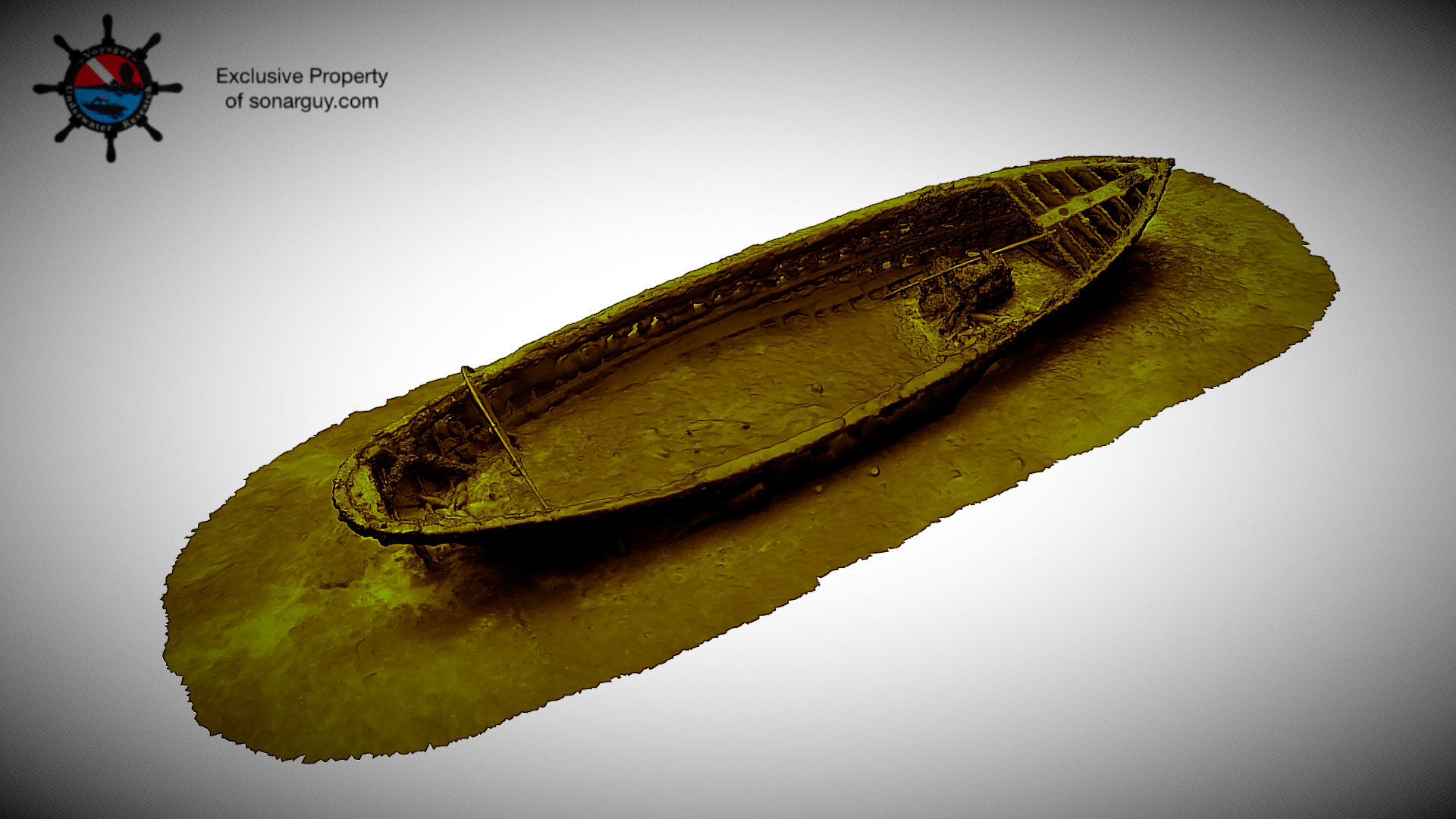
The Rum Runner
This wreck was discovered in 2016 by Tim Downing with side scan sonar. It is a fantail launch that for some reason was hauling a load of bottles that date back to the prohibition days. So we call this wreck the Rum Runner.

New Discovery on September 16, 2017. (The Wreck of the Hiawatha, Schooner Barge that sank on September 20, 1917.)
It was 4 AM Saturday morning when an image appears on the screen during a routine sonar expedition in Lake Ontario by Tim Caza and Dennis Gerber. There was a dive done two weeks after the discovery by Tim Caza and John Shaheen. The wreck is 70% intact and her Specs were 176.5 x 30 x11 with a cargo of hard coal aboard.

Steamer believed to be the Tug William Gardner that burned on Lake Ontario in May of 1883.
Steamer found by Tim Caza and Dennis Gerber off Galloo Island. The steamer is in deep water and it appears to have burned to the water line. Found on Sept. 23, 2015.

Small Sloop
This sloop is believed to be the Napoleon that sunk in 1835 with stones in her hold. Found by Tim Caza and Dennis Gerber on July 28, 2015.
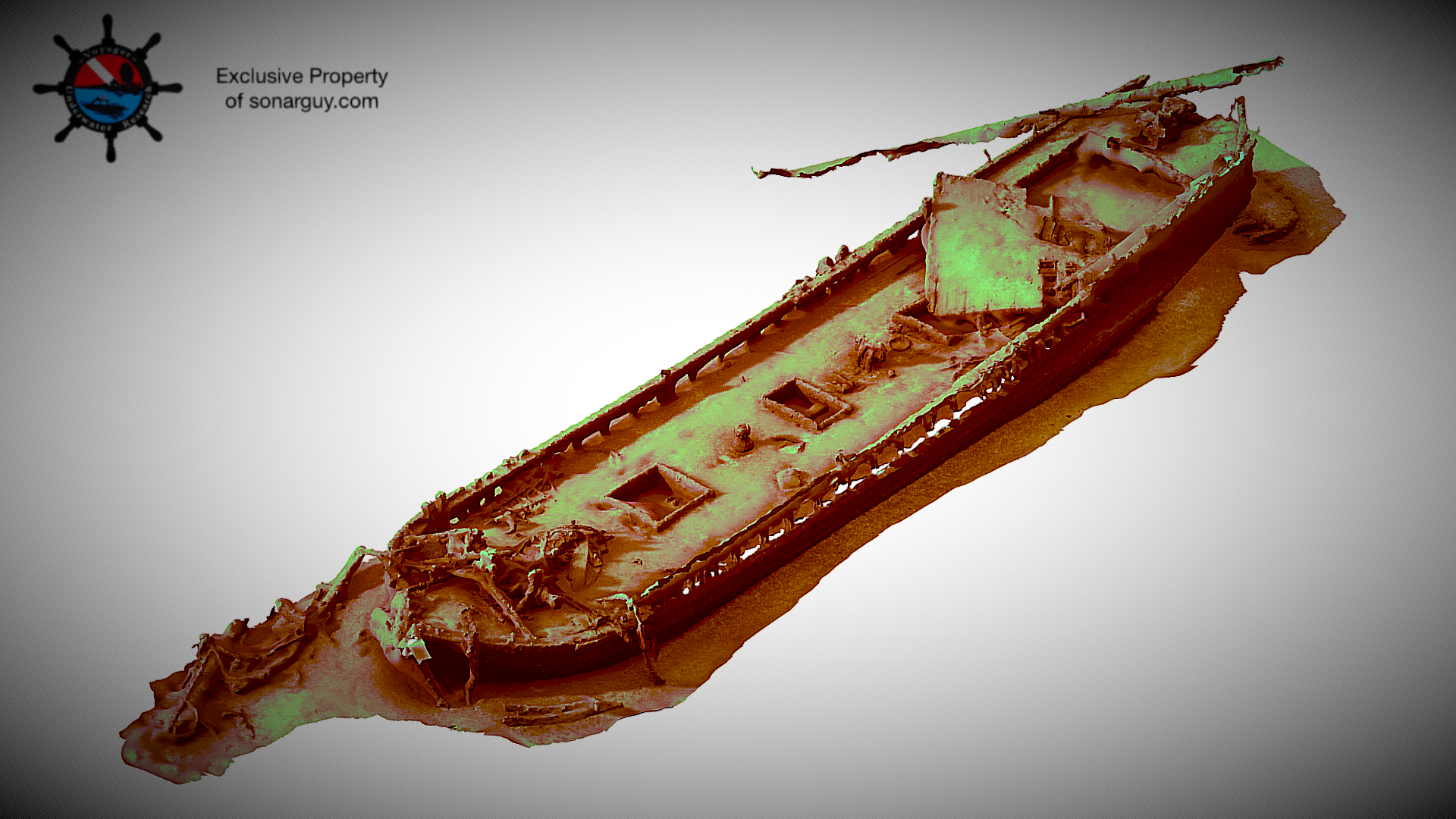
The wreck of the North Star, sunk on Nov 26, 1886
She was a wood schooner built in 1854 in Waterbury, Port Dover, Ontario. Her specs were 98x28x8, 149gc. She sank in Lake Ontario with a cargo of coal and was a total loss. Tim Caza found the North Star on September 4, 2014. The vessel is intact with the bowsprit broken off and lying on the bottom of the lake. The main boom is laying across the starboard backside of the vessel.
3D image of wreck Multi-Beam Sonar Image More

Believed to be the American sunk on October 1, 1894
The American was a wood schooner built in 1870, Asa Wilcox, Three Mile Bay, NY. The specs were 137x26x10, 269n. She was bound for Prescott, Ontario, in tow by the Tug Proctor. She sank for unreported reasons off Stony Point with a cargo of coal aboard. The wreck is mostly intact. Originally pinged with sonar by Tim Shippee and Dennis Gerber in August of 2008. New sonar images and photographs were taken on September 4, 2014 by Tim Caza and Dennis Gerber.

Wreck of the S.S. Ellsworth, sunk on July 9,1877
The Ellsworth was built in 1869 on Seneca Lake as a sailing vessel. In 1870 she was fitted up as a steam vessel. She was on a ten day cruise among the islands at the head of the St. Lawrence and vicinity. The Ellsworth was at anchor off Stony Island when a fire broke out in the kitchen causing the vessel to burn to the water line. She now lies in 21 feet of water off Stony Island.

The wreck of the H.B. sunk on October 17,1912. Schooner-barge, wood, bulk freight, 3-mast.
About twenty miles out in Lake Ontario Tim Caza and Dennis Gerber found the H.B. on July 8, 2016. Four persons lost their lives, J.D. Schamp, Steven Lebux, Fred Lahance, all Canadians, and Alice Derusha, the 16 year old daughter of the captain, John Derusha, of the H.B. The ill-fated schooner barge, with two others, was being towed from Oswego to Ogdensburg loaded with coal. The towline broke during a heavy windstorm and the H.B. went adrift. In a short time the H.B. went down. Her Specs were 176x34x13. 3D image of wreck

The wreck of the Menominee, or the wreck of the Buckley sunk on October 17,1912. There are different newspaper accounts on which vessels actually sunk in October of 1912. This is believed to be the Menominee based on this article below. We won't know for sure until we revisit the site in the future to gather more information.
Syracuse Herald New York 1912-10-17, Submitted by Stu Beitler. This morning the steamer Nicaragua sighted the Menominee and the tug Proctor with the barge Buckley and towed the tug and Buckley to Cape Vincent. Then she returned to get the Menominee, but before reaching her picked up Captain DERUSHA and his son ELMER, who had been floating on a hatchway since the line parted. As they started for the Menominee that boat went down, but her crew was saved.
The vessel is split wide open on the bottom, dumping all her cargo of coal.
Light Beacon
Light beacon found in Lake Ontario 56 feet below by Tim Caza and Dennis Gerber on July 8, 2016. The light stands upright on the bottom 20 feet tall and 36 feet from the top of the light to the surface of the water. This was a very interesting discovery.

Smoke stack to a steamer
This smoke stack was discovered in August of 2015 in deep waters off Lake Ontario. 2000 feet from the smoke stack we found a small rowboat on the bottom of the lake. We also have a target that is 70 feet long that sets 2400 feet away from the smoke stack. We believe it is the steamer that the smoke stack and rowboat came from. We have not had a chance to get back to that target at this time to verify if it is indeed the steamer. Based on the smoke stack it appears that there was a fire that broke out on board.

Smoke Stack
During a routine sonar expedition we picked up a small target in deep waters of Lake Ontario. It was on July 7, 2020 when we returned with our ROV to investigate the discovery. It turned out to be a smokestack to a steamer. Based on its location we believe it came from the tug William Gardner that caught fire and sunk in the lake.

Two Smokestacks to the Steamer Wisconsin discovered in Lake Ontario.
On the 19th day of May 1867 the steamer Wisconsin left Cape Vincent on route to Chicago with passengers and freight. About a mile or so off Tibbetts Point Lighthouse fire was discovered in the boiler room. All efforts of the crew to gain control of the fire were unsuccessful. The captain decided to beach the steamer on Grenadier Island but before reaching the island the steamer had become almost fully involved in flames. The steamer Wisconsin was a total loss. 22 bodies were recovered the following day and brought to Cape Vincent on the steamer Pierrepont.
One hundred fifty years later, Tim Caza and Dennis Gerber found the two smokestacks of the Wisconsin two and a half miles off Tibbetts Point Lighthouse in 85 feet of water. The smokestacks had fallen overboard as the fire burned around the support cables.


The remains of the Ariadne sunk in 1886.
It was July of 2020 when a number of timbers were discovered washed ashore north of Southwick Beach. With that discovery the locals said they have seen what they believe to be machinery in shallow waters in that area. Mark Barber went up to investigate and did some dives on the site. He found that it was the windlass belonging to the lost schooner Ariadne. Tim and Dennis joined Mark on August 15, 2020 to Map the area with sonar and take some underwater video of the discovery.
After mapping the area we found that the only visible remains of the Ariadne was the windlass, the bilge pump, a few timbers, and ballast stones. Even though the remains are only in 4 to 5 feet of water the winless was in remarkably good shape do to the sand wash and wave action.More

The recovery of a 26 foot fishing boat that sank in Lake Ontario in 147 feet of water.
Chris Martin was hired to retrieve this boat that sank in Lake Ontario in the season of 2019. Tim and Dennis assisted Chris in locating the boat and doing an underwater ROV survey of the site. After this survey was completed Chris was able to put a plan together to safely retrieve the vessel. There were a few weather delays but other than that the operation was a total success.

Sea Ray Sedan Bridge
Fire burned through the hull on a Sea Ray the vessel sank in 48 feet of water in Sackets Harbor.

Cabin Cruiser
Found December 8, 2015 in Lake Ontario by Tim Caza and Dennis Gerber in 68 feet of water.
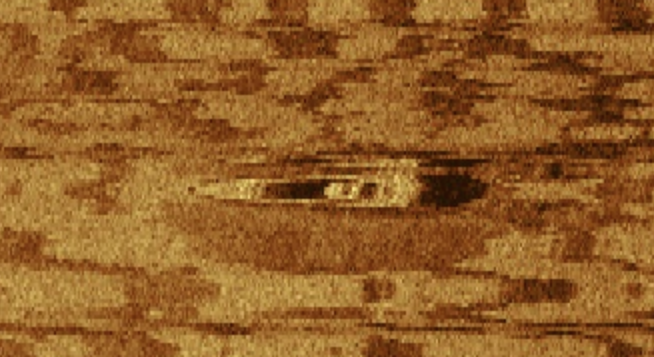
Please send us a Comment!





